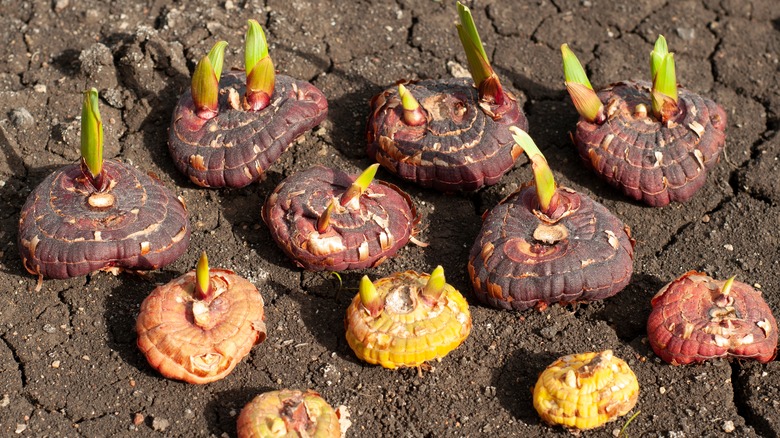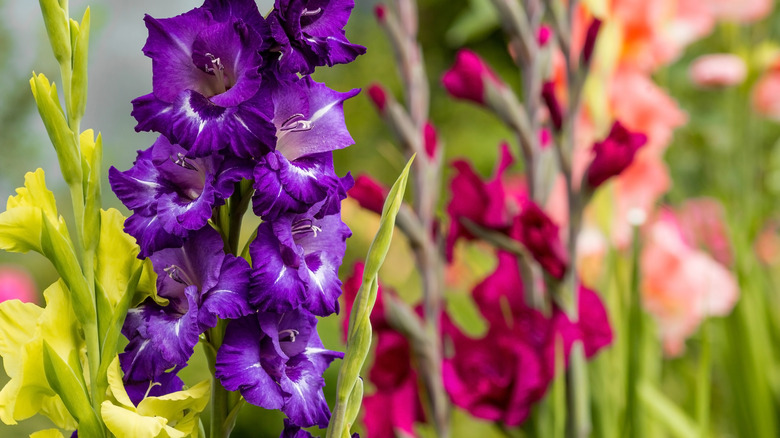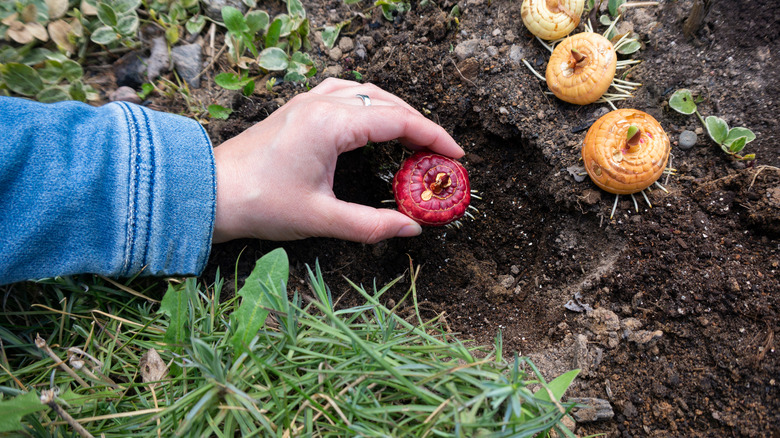This Is The Perfect Time To Plant Gladiolus Bulbs In Your Garden
Are you looking for a way to add dramatic color and appeal to your garden? Consider planting gladiolus (gladiolus spp) bulbs in your yard. This plant — which can reach a height as tall as 5 feet depending on the variety — is a stunner with big, showy flowers that typically bloom from the late spring through October, often with a deep pink color. Planting spring bulbs like gladiolus is something to do after the final frost of the year occurs. Since these are tender, more delicate bulbs, they do their best when the soil has started to warm up.
Keep in mind that the success of this plant depends on where you live. Typically, these bulbs do best in zones 7 to 10. They will bloom earlier in areas where the soil warms up sooner. One of the best tips is to plant some bulbs now and then wait a couple of weeks before planting another set. Since you can continue to plant through the first weeks of summer in most climates, this planting schedule will consistently provide you with long-lasting, ongoing blooms throughout the growing season.
It's important to create the best environment for gladiolus bulbs while planting them. Though these plants are typically easy to grow once they are placed, they need the right environment to thrive throughout the season. The good news is they're worth the bit of planning and work.
Choosing gladiolus bulbs for planting
Gladius bulbs, which are affectionately called "glads" for their beautiful, smile-producing flowers, can be a successful addition to your garden with a bit of planning. First, choose the bulbs that are best suited for your growing zone. Taller, stalk-like plants in a range of gorgeous colors are possible depending on the variety selected. Some options range from miniature to giant varieties, producing a range of flower sizes. It's always good to understand what the manufacturer recommends in terms of planting timeframes.
Choose healthy bulbs, which should have a smooth husk on the exterior that shows no noticeable discoloration, physical damage, or trauma. They typically have a firm feel to them and no scent. Smaller gladiolus varieties will have bulbs that are as small as ½ inch, while giant varieties are over 2 inches in diameter.
You next need to ensure the soil is suitable for the plants. The best time to plant gladiolus is after the risk of frost has passed, which means the soil should be loosened and easy to grow in. They do best in soil with a pH between 6 and 6.5 and soil that offers good overall drainage. Consider adding organic material like sawdust or compost to help support the bulb's nutritional needs. You can add fertilizer (5-10-5 versions are best) to the soil to support growth as well.
How to plant gladiolus bulbs for success
Once the threat of frost is over and the soil has warmed up a bit, it's possible to begin planting these bulbs. These are showy flowers that want all of the attention to themselves. For that reason, give them room and spread out their bulbs for the best results. If you plan to plant every two weeks, start with the largest varieties in the back of the flowerbed, where they will not block the sunlight from smaller varieties as they grow. These plants do best with at least 6 hours of direct sunlight daily.
Trench out the space the bulbs need based on the size of the plant. Mid-sized bulbs require about 3 to 4 inches of depth in the soil, while the smallest bulbs need about 2 to 3 inches of dirt above them to do well. Space out your rows to give them room, with as much as 20 to 36 inches of space between each row of bulbs ideal for larger plants. Place mid-sized bulbs every two to three inches in the row.
It will take a couple of weeks for the buds to begin to come up, and then you'll notice the glads blooming upwards from the base of the stalk. Keep the soil well-draining throughout this process. Within a matter of weeks, you'll be able to take cuttings from gladiolus to add beautiful color to your home.


